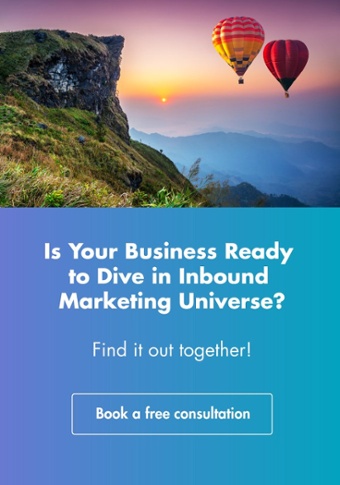The relationship between company and client walks on a very thin line, always balanced, in search of new equilibrium. The challenge facing a company in the modern-market, saturated with content, is building your own company-narrative and being able to break through this brick wall. Making a difference in the eyes of existing and potential clients.
What’s the right strategy to implement? Inbound marketing identified a winning element in corporate storytelling, based on creating contents that are the result of a deep sociological and anthropological analysis of a company’s clients.
It focuses on a customer-centric narrative, where the protagonist, “the hero”, isn’t the company itself but rather the clients with their pain-points, conflicts, bio-myths and bio-themes.
This is done through corporate storytelling, the representation of your audience’s current state of mind, which prompts a deep sense of empathy on their behalf.
We’re talking about storytelling in order to capture the attention of your interlocutors, creating a trance-like listening experience, and triggering their emotions on a very profound level.
Seeing your conflicts and personal fears represented in the company’s story, along with understanding how this supplies us with the right solution to overcome them, is the key element behind corporate storytelling; that’s what makes all the difference for creating a long-lasting relationship between company and client, based on trust.
Corporate storytelling: the narrative plan
How do you build a narrative plan? Using corporate storytelling isn’t about telling tales, as you often hear people say. It’s to do with an articulated route characterized by several steps.
The main 3 stages are:
- brief
- storymap
- core-story
The brief places attention on some fundamental points behind business-stories:
- reason why: why a company chooses to under take a narrative route
- audience: who your interlocutors are, what their pain-points, conflicts and challenges are
- tools
- timing
- costs
“It’s simply matter of empathizing what people really care and telling them a story about it. It’s creating a link between your readers and your brand! That’s #storytelling
Storymap: what is it and how is it created?
At this stage, the question to answer is this: how can we resolve the requests of clients with our company-story?
The story-map shows your audience’s life-journey which is defined through analyzing bio-myths, (what do they need: safety, care, evasion, force) and bio-themes, (main aspects: love, pain, death, work).
How to build a story-map?
The following steps lead to its creation:
- Analysis of audience-insight (analyze their current state of mind, the conflicts they face, their fears, their wounds)
- Biographical investigation to collect information on the lives of our audience
- Sociological and anthropological analysis of data
- Creation of matrices
Core-story: script and core-narrative
The last stage has to do with achieving a genuine core-story, or a script that encompasses the core-narrative, which we can break down in these crucial steps:
- status quo: the company-story represents a precise state of mind of your interlocutors
- drama: this dramatizes the conflicts, fears and wounds of your audience
- resolution: the company provides the solution to those conflicts
Corporate storytelling and Inbound Marketing to action: the story of funnel matrix
Now that we’ve seen how a narrative-plan is developed, let’s now look at how the company can strategically decide to deliver its narrations to clients and with what objectives in sight.
Planning the strategy for your company-story/ies is fundamental for effective communication.
In fact, the story of funnel matrix focuses on two mappings: the type of story and the time schedule.

The variables relating to the type of narration are three and correspond to the three stages of marketing funnel: awareness, consideration, acquisition:
- What you care about
- Who you are
- What you sell
Based on the specific objective, the company can plan the use of these stories on behalf of its interlocutors:
- Timely
- Seasonal
- Evergreen
Let’s look at two examples, one being American, the other Italian.
American Express Open Forum: top funnel stories
The first example of all is American Express Open Forum, within which a company posts contents that strictly address small businesses. There are three types of content:
- Solutions on how to make your business grow
- Updates on new laws and taxes
- Videos to promote small businesses during Small Business Saturday, the annual event.
American Express’s corporate storytelling has the aim of convincing small companies of how concerned they are about their the state of their business. These companies struggle to stay afloat on a daily basis, have the need to grow their business and have difficulty keeping up with the new laws and tax regulations. That’s why the type of narration offered by American Express is the prizewinner: it fully represents the conflicts and fears of the audience concerned. That audience recognizes AM as an ally for their business; a partner that delivers advice and important solutions.
The company story conveyed by American Express is positioned at the apex of the funnel matrix, inasmuch as it’s the combination between the “What you care” strategic plan which, in this case, encompasses all of the time schedules: evergreen (contents related to solutions that help grow a business), timely (updates on laws and taxes) and, finally, seasonal (videos to promote Small Business Saturday).
Wind, Institutional Communications Campaign 2015 “Daddy”: evergreen story
Another example of corporate storytelling is top funnel. It’s totally homegrown and focuses on Wind’s “Daddy” institutional-communications-campaign, produced in 2015 by Ogilvy & Mother.
With this campaign, an exciting and captivating short film, Wind deals with “a theme that’s universal and relevant right now, which is the debate on the consequences of technology becoming more and more pervasive in relation to peoples’ personal lives. The intent behind this campaign is that of communicating an important value: the value of proximity.
Let’s analyze the core-narrative of the campaign:
- Status quo: father and son are far from one another, they live in different cities
- Drama: the son tries contacting his father using technology, (sms, email), it gets difficult
- Resolution: the son decides to set off and catch up with his father. This is because technology is far from omnipotent and could never substitute the value of proximity and first-person-contact.
In this case, the types of story are both “What you care about” and “Who you are”. Wind takes cares of peoples’ feelings and transmits one of its main values: closeness.
Speaking of universal themes, we’re facing an evergreen. Hence, even in this case, corporate storytelling positions itself at the apex of the story funnel matrix.
For a company, implementing corporate storytelling means rolling up your sleeves to create an ecosystem of company-stories with the objective of generating membership and sense-making. Clients are the heroes of the stories. They’re the ones who step on the pitch and, thanks to the treasures offered by companies, manage to overcome their fears, wounds and conflicts.
Got interested and you’d like to start telling your own story?
We’ll tell you how to do it!

